Business Process Management and Systems Development Plan Report
VerifiedAdded on 2022/10/09
|13
|4383
|22
Report
AI Summary
This report, developed for the PROJ6009 Business Process Management and Systems course, provides a comprehensive analysis of business process management (BPM) and systems, focusing on real-world applications and improvement strategies. The report is divided into two main parts: Part A examines the role of BPM, evaluates various approaches, and includes As-Is and To-Be process mapping. Part B presents a business process improvement report, including performance evaluation. The analysis uses PPG Paints as a case study, illustrating the application of BPM principles such as process maps, RACI models, SIPOC, and data analysis to enhance efficiency, reduce costs, and improve customer satisfaction. The report also covers auditing techniques, compliance, and data analysis for process improvements, offering a practical understanding of BPM implementation and its impact on organizational success.

Business process management and system
Paraphrase This Document
Need a fresh take? Get an instant paraphrase of this document with our AI Paraphraser
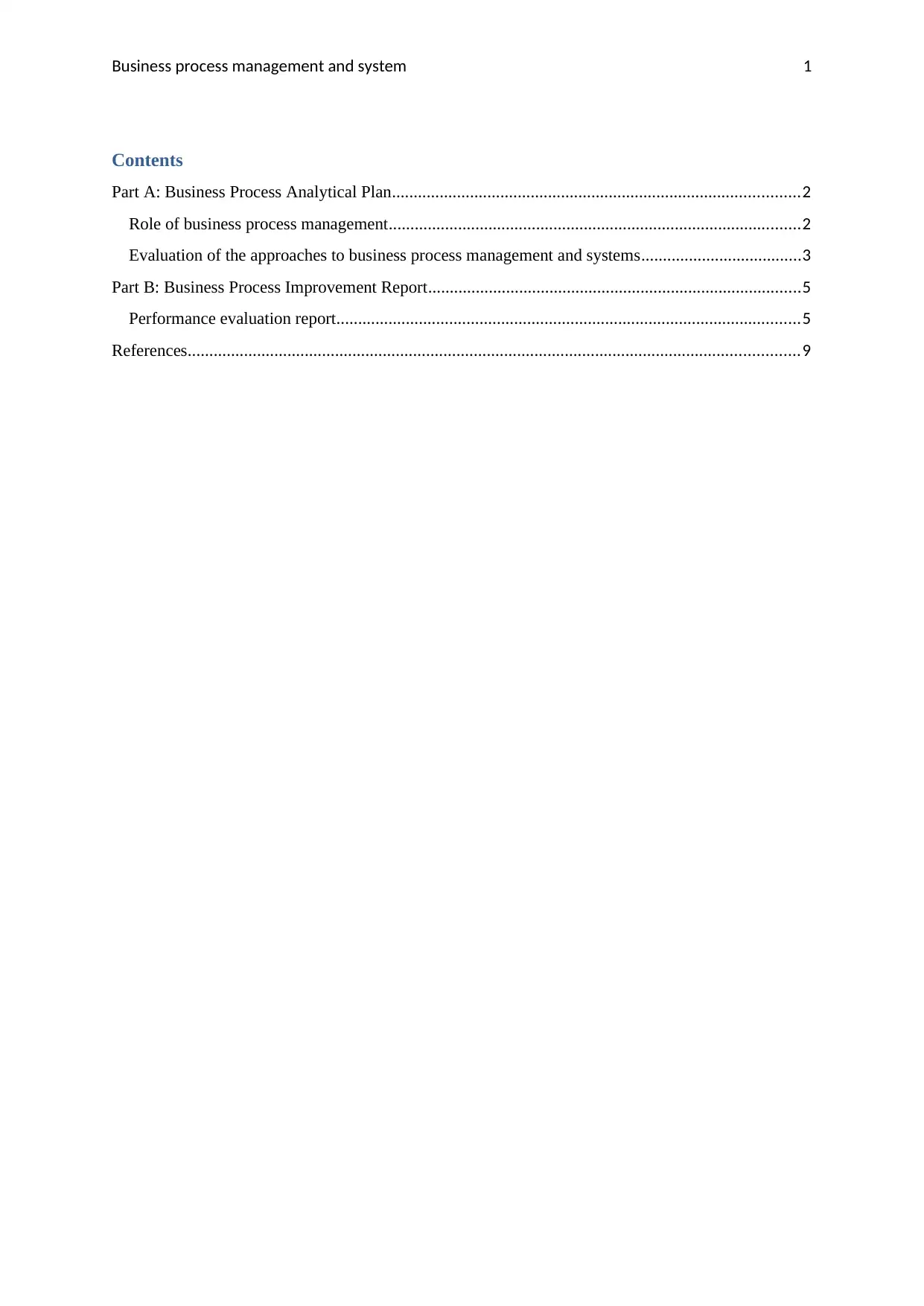
Business process management and system 1
Contents
Part A: Business Process Analytical Plan..............................................................................................2
Role of business process management...............................................................................................2
Evaluation of the approaches to business process management and systems.....................................3
Part B: Business Process Improvement Report......................................................................................5
Performance evaluation report...........................................................................................................5
References.............................................................................................................................................9
Contents
Part A: Business Process Analytical Plan..............................................................................................2
Role of business process management...............................................................................................2
Evaluation of the approaches to business process management and systems.....................................3
Part B: Business Process Improvement Report......................................................................................5
Performance evaluation report...........................................................................................................5
References.............................................................................................................................................9
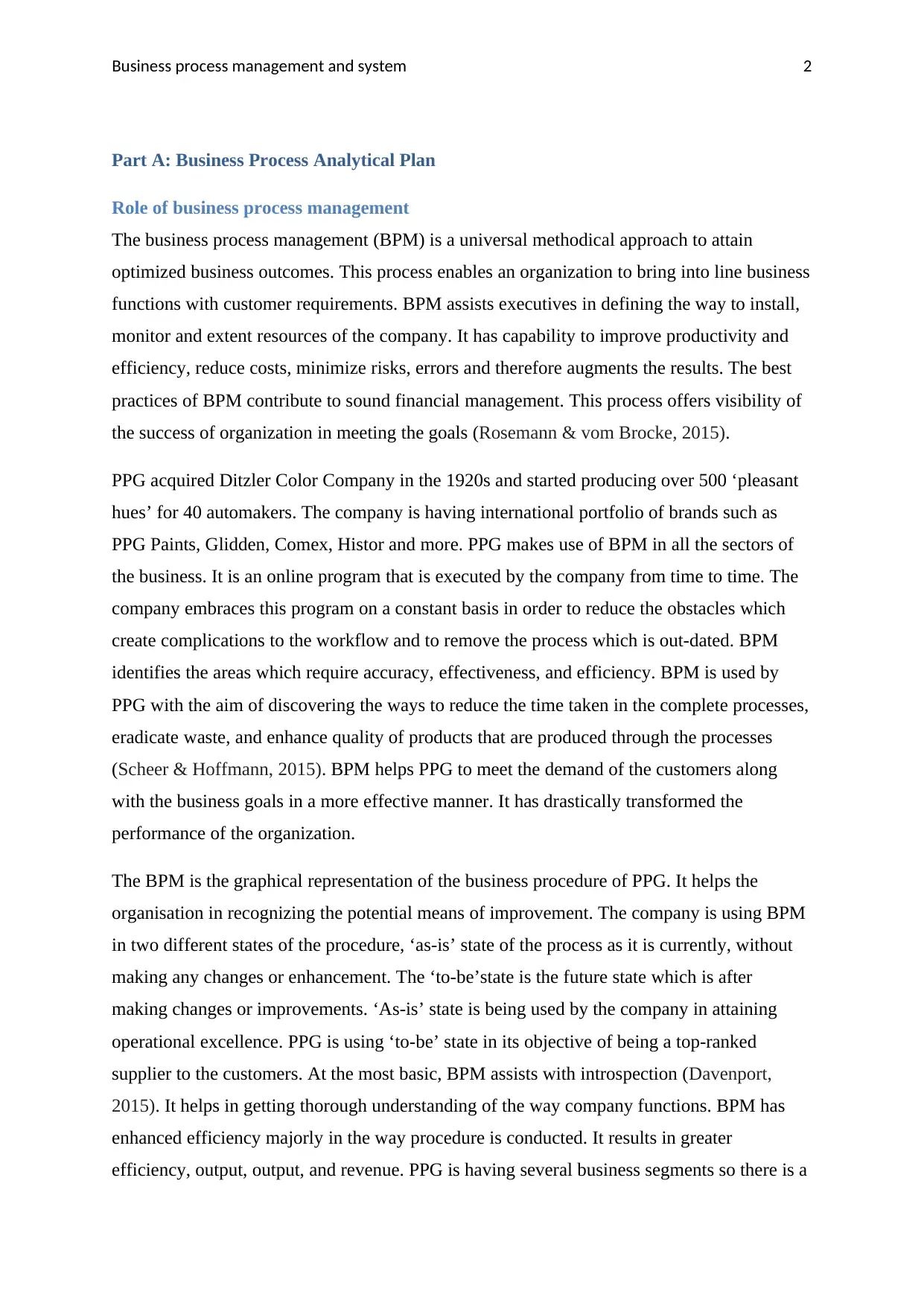
Business process management and system 2
Part A: Business Process Analytical Plan
Role of business process management
The business process management (BPM) is a universal methodical approach to attain
optimized business outcomes. This process enables an organization to bring into line business
functions with customer requirements. BPM assists executives in defining the way to install,
monitor and extent resources of the company. It has capability to improve productivity and
efficiency, reduce costs, minimize risks, errors and therefore augments the results. The best
practices of BPM contribute to sound financial management. This process offers visibility of
the success of organization in meeting the goals (Rosemann & vom Brocke, 2015).
PPG acquired Ditzler Color Company in the 1920s and started producing over 500 ‘pleasant
hues’ for 40 automakers. The company is having international portfolio of brands such as
PPG Paints, Glidden, Comex, Histor and more. PPG makes use of BPM in all the sectors of
the business. It is an online program that is executed by the company from time to time. The
company embraces this program on a constant basis in order to reduce the obstacles which
create complications to the workflow and to remove the process which is out-dated. BPM
identifies the areas which require accuracy, effectiveness, and efficiency. BPM is used by
PPG with the aim of discovering the ways to reduce the time taken in the complete processes,
eradicate waste, and enhance quality of products that are produced through the processes
(Scheer & Hoffmann, 2015). BPM helps PPG to meet the demand of the customers along
with the business goals in a more effective manner. It has drastically transformed the
performance of the organization.
The BPM is the graphical representation of the business procedure of PPG. It helps the
organisation in recognizing the potential means of improvement. The company is using BPM
in two different states of the procedure, ‘as-is’ state of the process as it is currently, without
making any changes or enhancement. The ‘to-be’state is the future state which is after
making changes or improvements. ‘As-is’ state is being used by the company in attaining
operational excellence. PPG is using ‘to-be’ state in its objective of being a top-ranked
supplier to the customers. At the most basic, BPM assists with introspection (Davenport,
2015). It helps in getting thorough understanding of the way company functions. BPM has
enhanced efficiency majorly in the way procedure is conducted. It results in greater
efficiency, output, output, and revenue. PPG is having several business segments so there is a
Part A: Business Process Analytical Plan
Role of business process management
The business process management (BPM) is a universal methodical approach to attain
optimized business outcomes. This process enables an organization to bring into line business
functions with customer requirements. BPM assists executives in defining the way to install,
monitor and extent resources of the company. It has capability to improve productivity and
efficiency, reduce costs, minimize risks, errors and therefore augments the results. The best
practices of BPM contribute to sound financial management. This process offers visibility of
the success of organization in meeting the goals (Rosemann & vom Brocke, 2015).
PPG acquired Ditzler Color Company in the 1920s and started producing over 500 ‘pleasant
hues’ for 40 automakers. The company is having international portfolio of brands such as
PPG Paints, Glidden, Comex, Histor and more. PPG makes use of BPM in all the sectors of
the business. It is an online program that is executed by the company from time to time. The
company embraces this program on a constant basis in order to reduce the obstacles which
create complications to the workflow and to remove the process which is out-dated. BPM
identifies the areas which require accuracy, effectiveness, and efficiency. BPM is used by
PPG with the aim of discovering the ways to reduce the time taken in the complete processes,
eradicate waste, and enhance quality of products that are produced through the processes
(Scheer & Hoffmann, 2015). BPM helps PPG to meet the demand of the customers along
with the business goals in a more effective manner. It has drastically transformed the
performance of the organization.
The BPM is the graphical representation of the business procedure of PPG. It helps the
organisation in recognizing the potential means of improvement. The company is using BPM
in two different states of the procedure, ‘as-is’ state of the process as it is currently, without
making any changes or enhancement. The ‘to-be’state is the future state which is after
making changes or improvements. ‘As-is’ state is being used by the company in attaining
operational excellence. PPG is using ‘to-be’ state in its objective of being a top-ranked
supplier to the customers. At the most basic, BPM assists with introspection (Davenport,
2015). It helps in getting thorough understanding of the way company functions. BPM has
enhanced efficiency majorly in the way procedure is conducted. It results in greater
efficiency, output, output, and revenue. PPG is having several business segments so there is a
⊘ This is a preview!⊘
Do you want full access?
Subscribe today to unlock all pages.

Trusted by 1+ million students worldwide
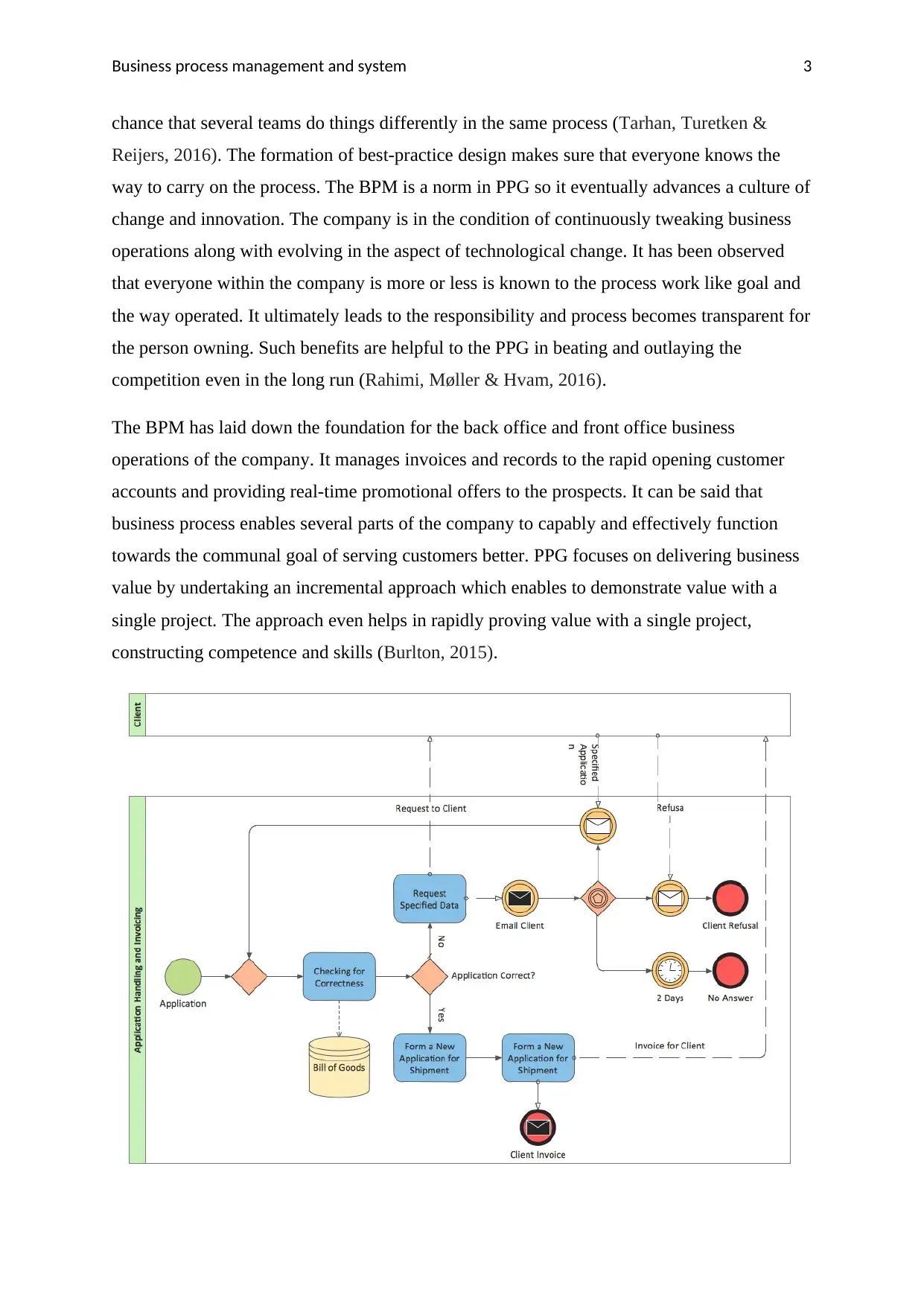
Business process management and system 3
chance that several teams do things differently in the same process (Tarhan, Turetken &
Reijers, 2016). The formation of best-practice design makes sure that everyone knows the
way to carry on the process. The BPM is a norm in PPG so it eventually advances a culture of
change and innovation. The company is in the condition of continuously tweaking business
operations along with evolving in the aspect of technological change. It has been observed
that everyone within the company is more or less is known to the process work like goal and
the way operated. It ultimately leads to the responsibility and process becomes transparent for
the person owning. Such benefits are helpful to the PPG in beating and outlaying the
competition even in the long run (Rahimi, Møller & Hvam, 2016).
The BPM has laid down the foundation for the back office and front office business
operations of the company. It manages invoices and records to the rapid opening customer
accounts and providing real-time promotional offers to the prospects. It can be said that
business process enables several parts of the company to capably and effectively function
towards the communal goal of serving customers better. PPG focuses on delivering business
value by undertaking an incremental approach which enables to demonstrate value with a
single project. The approach even helps in rapidly proving value with a single project,
constructing competence and skills (Burlton, 2015).
chance that several teams do things differently in the same process (Tarhan, Turetken &
Reijers, 2016). The formation of best-practice design makes sure that everyone knows the
way to carry on the process. The BPM is a norm in PPG so it eventually advances a culture of
change and innovation. The company is in the condition of continuously tweaking business
operations along with evolving in the aspect of technological change. It has been observed
that everyone within the company is more or less is known to the process work like goal and
the way operated. It ultimately leads to the responsibility and process becomes transparent for
the person owning. Such benefits are helpful to the PPG in beating and outlaying the
competition even in the long run (Rahimi, Møller & Hvam, 2016).
The BPM has laid down the foundation for the back office and front office business
operations of the company. It manages invoices and records to the rapid opening customer
accounts and providing real-time promotional offers to the prospects. It can be said that
business process enables several parts of the company to capably and effectively function
towards the communal goal of serving customers better. PPG focuses on delivering business
value by undertaking an incremental approach which enables to demonstrate value with a
single project. The approach even helps in rapidly proving value with a single project,
constructing competence and skills (Burlton, 2015).
Paraphrase This Document
Need a fresh take? Get an instant paraphrase of this document with our AI Paraphraser
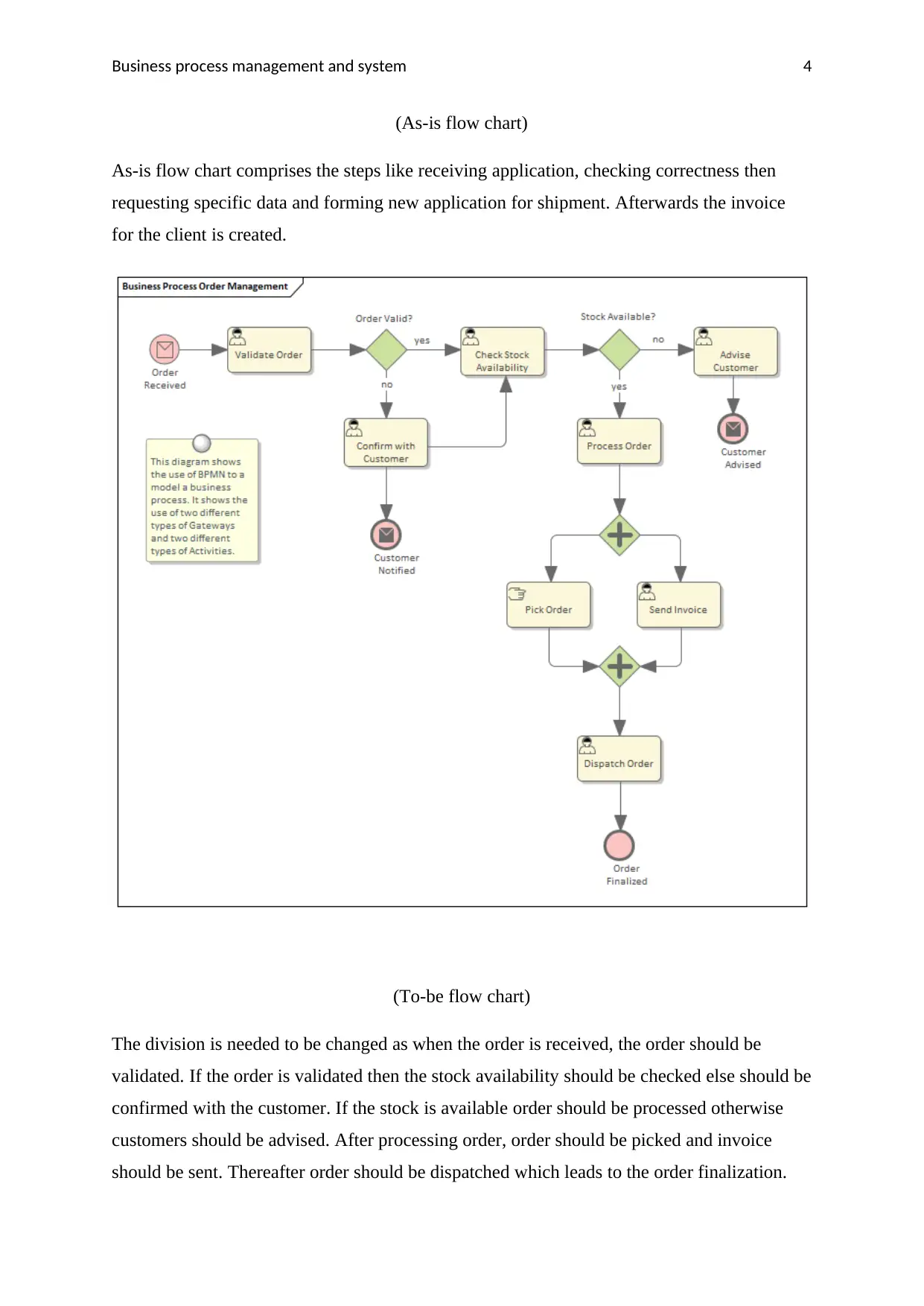
Business process management and system 4
(As-is flow chart)
As-is flow chart comprises the steps like receiving application, checking correctness then
requesting specific data and forming new application for shipment. Afterwards the invoice
for the client is created.
(To-be flow chart)
The division is needed to be changed as when the order is received, the order should be
validated. If the order is validated then the stock availability should be checked else should be
confirmed with the customer. If the stock is available order should be processed otherwise
customers should be advised. After processing order, order should be picked and invoice
should be sent. Thereafter order should be dispatched which leads to the order finalization.
(As-is flow chart)
As-is flow chart comprises the steps like receiving application, checking correctness then
requesting specific data and forming new application for shipment. Afterwards the invoice
for the client is created.
(To-be flow chart)
The division is needed to be changed as when the order is received, the order should be
validated. If the order is validated then the stock availability should be checked else should be
confirmed with the customer. If the stock is available order should be processed otherwise
customers should be advised. After processing order, order should be picked and invoice
should be sent. Thereafter order should be dispatched which leads to the order finalization.
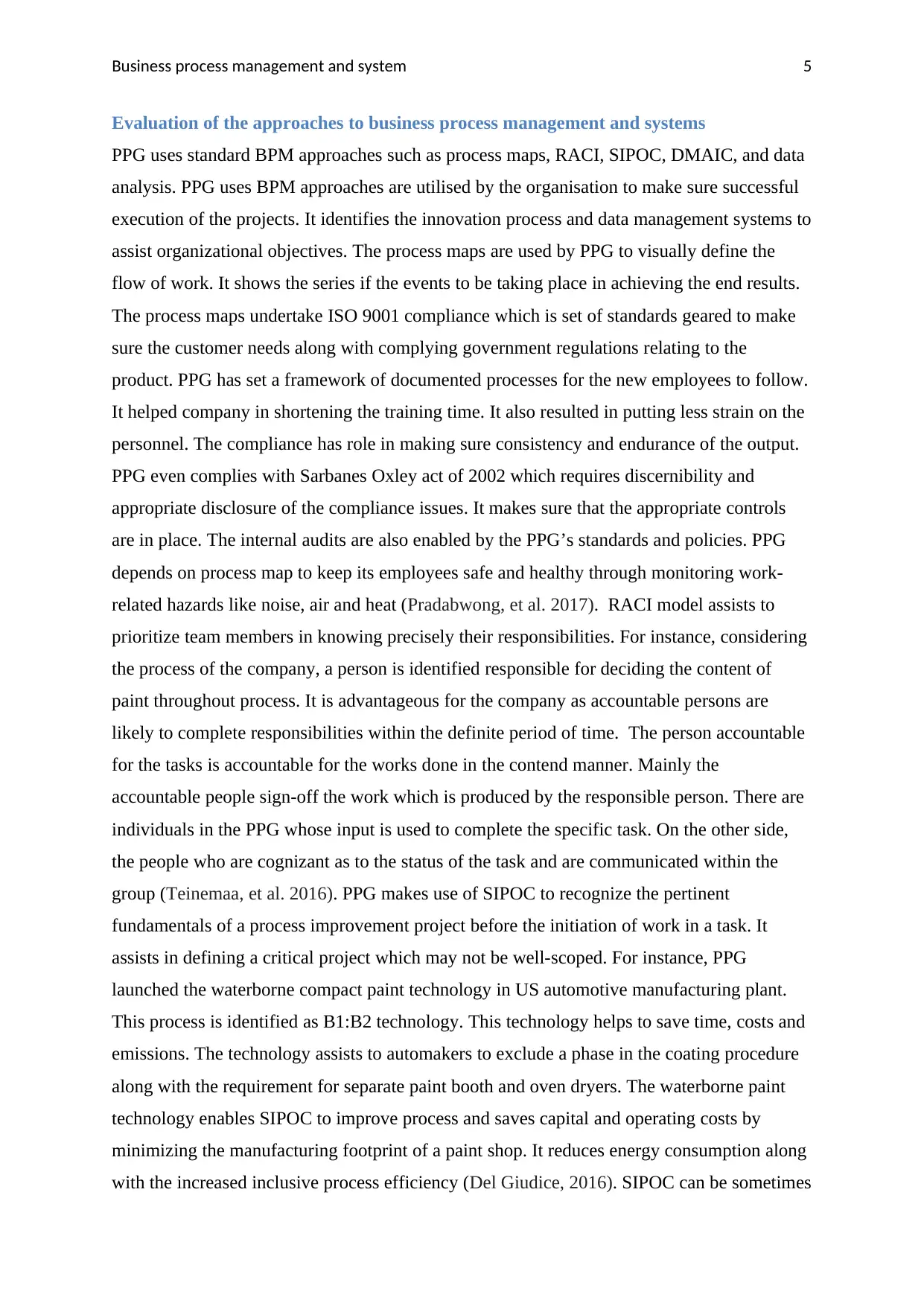
Business process management and system 5
Evaluation of the approaches to business process management and systems
PPG uses standard BPM approaches such as process maps, RACI, SIPOC, DMAIC, and data
analysis. PPG uses BPM approaches are utilised by the organisation to make sure successful
execution of the projects. It identifies the innovation process and data management systems to
assist organizational objectives. The process maps are used by PPG to visually define the
flow of work. It shows the series if the events to be taking place in achieving the end results.
The process maps undertake ISO 9001 compliance which is set of standards geared to make
sure the customer needs along with complying government regulations relating to the
product. PPG has set a framework of documented processes for the new employees to follow.
It helped company in shortening the training time. It also resulted in putting less strain on the
personnel. The compliance has role in making sure consistency and endurance of the output.
PPG even complies with Sarbanes Oxley act of 2002 which requires discernibility and
appropriate disclosure of the compliance issues. It makes sure that the appropriate controls
are in place. The internal audits are also enabled by the PPG’s standards and policies. PPG
depends on process map to keep its employees safe and healthy through monitoring work-
related hazards like noise, air and heat (Pradabwong, et al. 2017). RACI model assists to
prioritize team members in knowing precisely their responsibilities. For instance, considering
the process of the company, a person is identified responsible for deciding the content of
paint throughout process. It is advantageous for the company as accountable persons are
likely to complete responsibilities within the definite period of time. The person accountable
for the tasks is accountable for the works done in the contend manner. Mainly the
accountable people sign-off the work which is produced by the responsible person. There are
individuals in the PPG whose input is used to complete the specific task. On the other side,
the people who are cognizant as to the status of the task and are communicated within the
group (Teinemaa, et al. 2016). PPG makes use of SIPOC to recognize the pertinent
fundamentals of a process improvement project before the initiation of work in a task. It
assists in defining a critical project which may not be well-scoped. For instance, PPG
launched the waterborne compact paint technology in US automotive manufacturing plant.
This process is identified as B1:B2 technology. This technology helps to save time, costs and
emissions. The technology assists to automakers to exclude a phase in the coating procedure
along with the requirement for separate paint booth and oven dryers. The waterborne paint
technology enables SIPOC to improve process and saves capital and operating costs by
minimizing the manufacturing footprint of a paint shop. It reduces energy consumption along
with the increased inclusive process efficiency (Del Giudice, 2016). SIPOC can be sometimes
Evaluation of the approaches to business process management and systems
PPG uses standard BPM approaches such as process maps, RACI, SIPOC, DMAIC, and data
analysis. PPG uses BPM approaches are utilised by the organisation to make sure successful
execution of the projects. It identifies the innovation process and data management systems to
assist organizational objectives. The process maps are used by PPG to visually define the
flow of work. It shows the series if the events to be taking place in achieving the end results.
The process maps undertake ISO 9001 compliance which is set of standards geared to make
sure the customer needs along with complying government regulations relating to the
product. PPG has set a framework of documented processes for the new employees to follow.
It helped company in shortening the training time. It also resulted in putting less strain on the
personnel. The compliance has role in making sure consistency and endurance of the output.
PPG even complies with Sarbanes Oxley act of 2002 which requires discernibility and
appropriate disclosure of the compliance issues. It makes sure that the appropriate controls
are in place. The internal audits are also enabled by the PPG’s standards and policies. PPG
depends on process map to keep its employees safe and healthy through monitoring work-
related hazards like noise, air and heat (Pradabwong, et al. 2017). RACI model assists to
prioritize team members in knowing precisely their responsibilities. For instance, considering
the process of the company, a person is identified responsible for deciding the content of
paint throughout process. It is advantageous for the company as accountable persons are
likely to complete responsibilities within the definite period of time. The person accountable
for the tasks is accountable for the works done in the contend manner. Mainly the
accountable people sign-off the work which is produced by the responsible person. There are
individuals in the PPG whose input is used to complete the specific task. On the other side,
the people who are cognizant as to the status of the task and are communicated within the
group (Teinemaa, et al. 2016). PPG makes use of SIPOC to recognize the pertinent
fundamentals of a process improvement project before the initiation of work in a task. It
assists in defining a critical project which may not be well-scoped. For instance, PPG
launched the waterborne compact paint technology in US automotive manufacturing plant.
This process is identified as B1:B2 technology. This technology helps to save time, costs and
emissions. The technology assists to automakers to exclude a phase in the coating procedure
along with the requirement for separate paint booth and oven dryers. The waterborne paint
technology enables SIPOC to improve process and saves capital and operating costs by
minimizing the manufacturing footprint of a paint shop. It reduces energy consumption along
with the increased inclusive process efficiency (Del Giudice, 2016). SIPOC can be sometimes
⊘ This is a preview!⊘
Do you want full access?
Subscribe today to unlock all pages.

Trusted by 1+ million students worldwide
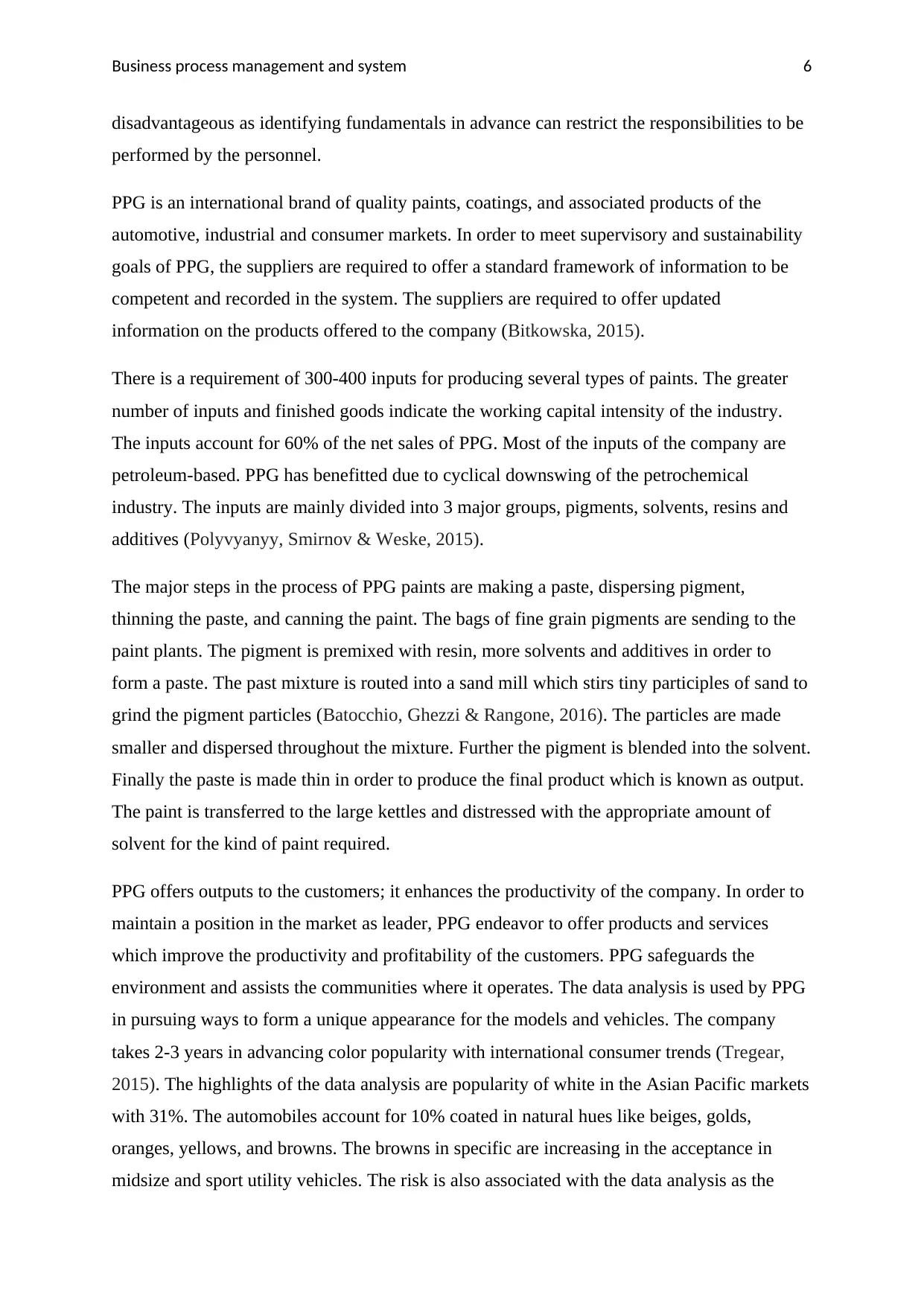
Business process management and system 6
disadvantageous as identifying fundamentals in advance can restrict the responsibilities to be
performed by the personnel.
PPG is an international brand of quality paints, coatings, and associated products of the
automotive, industrial and consumer markets. In order to meet supervisory and sustainability
goals of PPG, the suppliers are required to offer a standard framework of information to be
competent and recorded in the system. The suppliers are required to offer updated
information on the products offered to the company (Bitkowska, 2015).
There is a requirement of 300-400 inputs for producing several types of paints. The greater
number of inputs and finished goods indicate the working capital intensity of the industry.
The inputs account for 60% of the net sales of PPG. Most of the inputs of the company are
petroleum-based. PPG has benefitted due to cyclical downswing of the petrochemical
industry. The inputs are mainly divided into 3 major groups, pigments, solvents, resins and
additives (Polyvyanyy, Smirnov & Weske, 2015).
The major steps in the process of PPG paints are making a paste, dispersing pigment,
thinning the paste, and canning the paint. The bags of fine grain pigments are sending to the
paint plants. The pigment is premixed with resin, more solvents and additives in order to
form a paste. The past mixture is routed into a sand mill which stirs tiny participles of sand to
grind the pigment particles (Batocchio, Ghezzi & Rangone, 2016). The particles are made
smaller and dispersed throughout the mixture. Further the pigment is blended into the solvent.
Finally the paste is made thin in order to produce the final product which is known as output.
The paint is transferred to the large kettles and distressed with the appropriate amount of
solvent for the kind of paint required.
PPG offers outputs to the customers; it enhances the productivity of the company. In order to
maintain a position in the market as leader, PPG endeavor to offer products and services
which improve the productivity and profitability of the customers. PPG safeguards the
environment and assists the communities where it operates. The data analysis is used by PPG
in pursuing ways to form a unique appearance for the models and vehicles. The company
takes 2-3 years in advancing color popularity with international consumer trends (Tregear,
2015). The highlights of the data analysis are popularity of white in the Asian Pacific markets
with 31%. The automobiles account for 10% coated in natural hues like beiges, golds,
oranges, yellows, and browns. The browns in specific are increasing in the acceptance in
midsize and sport utility vehicles. The risk is also associated with the data analysis as the
disadvantageous as identifying fundamentals in advance can restrict the responsibilities to be
performed by the personnel.
PPG is an international brand of quality paints, coatings, and associated products of the
automotive, industrial and consumer markets. In order to meet supervisory and sustainability
goals of PPG, the suppliers are required to offer a standard framework of information to be
competent and recorded in the system. The suppliers are required to offer updated
information on the products offered to the company (Bitkowska, 2015).
There is a requirement of 300-400 inputs for producing several types of paints. The greater
number of inputs and finished goods indicate the working capital intensity of the industry.
The inputs account for 60% of the net sales of PPG. Most of the inputs of the company are
petroleum-based. PPG has benefitted due to cyclical downswing of the petrochemical
industry. The inputs are mainly divided into 3 major groups, pigments, solvents, resins and
additives (Polyvyanyy, Smirnov & Weske, 2015).
The major steps in the process of PPG paints are making a paste, dispersing pigment,
thinning the paste, and canning the paint. The bags of fine grain pigments are sending to the
paint plants. The pigment is premixed with resin, more solvents and additives in order to
form a paste. The past mixture is routed into a sand mill which stirs tiny participles of sand to
grind the pigment particles (Batocchio, Ghezzi & Rangone, 2016). The particles are made
smaller and dispersed throughout the mixture. Further the pigment is blended into the solvent.
Finally the paste is made thin in order to produce the final product which is known as output.
The paint is transferred to the large kettles and distressed with the appropriate amount of
solvent for the kind of paint required.
PPG offers outputs to the customers; it enhances the productivity of the company. In order to
maintain a position in the market as leader, PPG endeavor to offer products and services
which improve the productivity and profitability of the customers. PPG safeguards the
environment and assists the communities where it operates. The data analysis is used by PPG
in pursuing ways to form a unique appearance for the models and vehicles. The company
takes 2-3 years in advancing color popularity with international consumer trends (Tregear,
2015). The highlights of the data analysis are popularity of white in the Asian Pacific markets
with 31%. The automobiles account for 10% coated in natural hues like beiges, golds,
oranges, yellows, and browns. The browns in specific are increasing in the acceptance in
midsize and sport utility vehicles. The risk is also associated with the data analysis as the
Paraphrase This Document
Need a fresh take? Get an instant paraphrase of this document with our AI Paraphraser
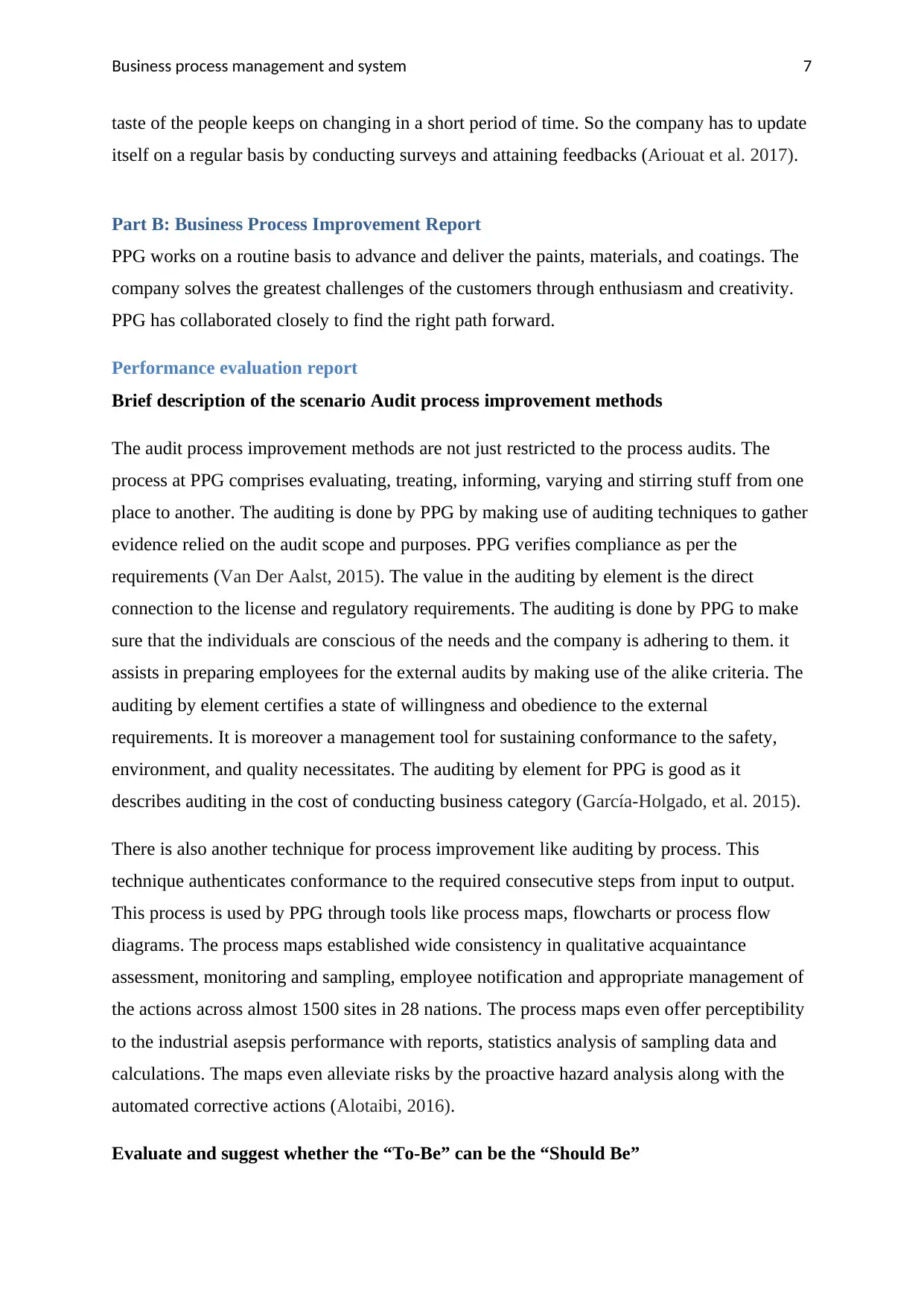
Business process management and system 7
taste of the people keeps on changing in a short period of time. So the company has to update
itself on a regular basis by conducting surveys and attaining feedbacks (Ariouat et al. 2017).
Part B: Business Process Improvement Report
PPG works on a routine basis to advance and deliver the paints, materials, and coatings. The
company solves the greatest challenges of the customers through enthusiasm and creativity.
PPG has collaborated closely to find the right path forward.
Performance evaluation report
Brief description of the scenario Audit process improvement methods
The audit process improvement methods are not just restricted to the process audits. The
process at PPG comprises evaluating, treating, informing, varying and stirring stuff from one
place to another. The auditing is done by PPG by making use of auditing techniques to gather
evidence relied on the audit scope and purposes. PPG verifies compliance as per the
requirements (Van Der Aalst, 2015). The value in the auditing by element is the direct
connection to the license and regulatory requirements. The auditing is done by PPG to make
sure that the individuals are conscious of the needs and the company is adhering to them. it
assists in preparing employees for the external audits by making use of the alike criteria. The
auditing by element certifies a state of willingness and obedience to the external
requirements. It is moreover a management tool for sustaining conformance to the safety,
environment, and quality necessitates. The auditing by element for PPG is good as it
describes auditing in the cost of conducting business category (García-Holgado, et al. 2015).
There is also another technique for process improvement like auditing by process. This
technique authenticates conformance to the required consecutive steps from input to output.
This process is used by PPG through tools like process maps, flowcharts or process flow
diagrams. The process maps established wide consistency in qualitative acquaintance
assessment, monitoring and sampling, employee notification and appropriate management of
the actions across almost 1500 sites in 28 nations. The process maps even offer perceptibility
to the industrial asepsis performance with reports, statistics analysis of sampling data and
calculations. The maps even alleviate risks by the proactive hazard analysis along with the
automated corrective actions (Alotaibi, 2016).
Evaluate and suggest whether the “To-Be” can be the “Should Be”
taste of the people keeps on changing in a short period of time. So the company has to update
itself on a regular basis by conducting surveys and attaining feedbacks (Ariouat et al. 2017).
Part B: Business Process Improvement Report
PPG works on a routine basis to advance and deliver the paints, materials, and coatings. The
company solves the greatest challenges of the customers through enthusiasm and creativity.
PPG has collaborated closely to find the right path forward.
Performance evaluation report
Brief description of the scenario Audit process improvement methods
The audit process improvement methods are not just restricted to the process audits. The
process at PPG comprises evaluating, treating, informing, varying and stirring stuff from one
place to another. The auditing is done by PPG by making use of auditing techniques to gather
evidence relied on the audit scope and purposes. PPG verifies compliance as per the
requirements (Van Der Aalst, 2015). The value in the auditing by element is the direct
connection to the license and regulatory requirements. The auditing is done by PPG to make
sure that the individuals are conscious of the needs and the company is adhering to them. it
assists in preparing employees for the external audits by making use of the alike criteria. The
auditing by element certifies a state of willingness and obedience to the external
requirements. It is moreover a management tool for sustaining conformance to the safety,
environment, and quality necessitates. The auditing by element for PPG is good as it
describes auditing in the cost of conducting business category (García-Holgado, et al. 2015).
There is also another technique for process improvement like auditing by process. This
technique authenticates conformance to the required consecutive steps from input to output.
This process is used by PPG through tools like process maps, flowcharts or process flow
diagrams. The process maps established wide consistency in qualitative acquaintance
assessment, monitoring and sampling, employee notification and appropriate management of
the actions across almost 1500 sites in 28 nations. The process maps even offer perceptibility
to the industrial asepsis performance with reports, statistics analysis of sampling data and
calculations. The maps even alleviate risks by the proactive hazard analysis along with the
automated corrective actions (Alotaibi, 2016).
Evaluate and suggest whether the “To-Be” can be the “Should Be”
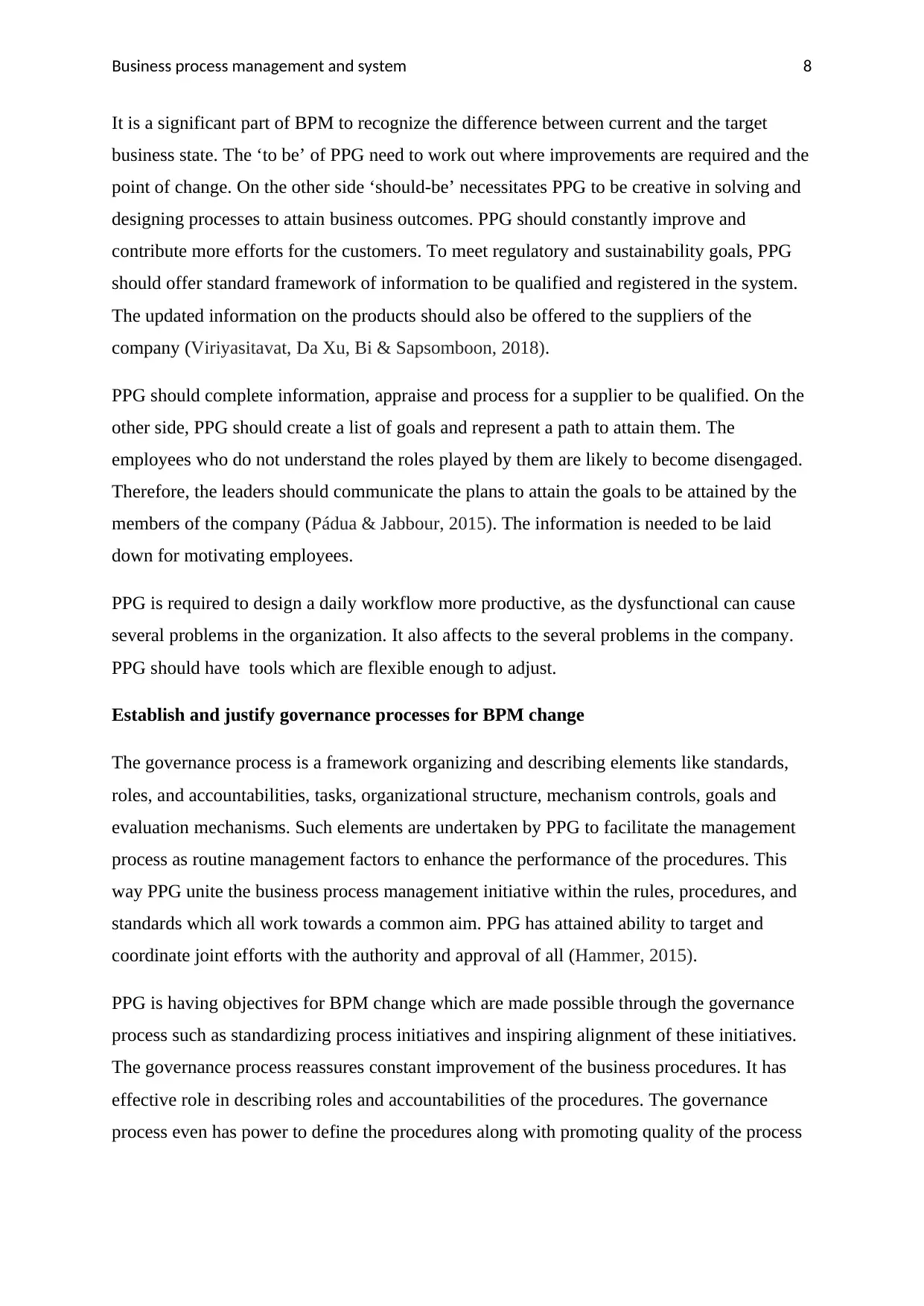
Business process management and system 8
It is a significant part of BPM to recognize the difference between current and the target
business state. The ‘to be’ of PPG need to work out where improvements are required and the
point of change. On the other side ‘should-be’ necessitates PPG to be creative in solving and
designing processes to attain business outcomes. PPG should constantly improve and
contribute more efforts for the customers. To meet regulatory and sustainability goals, PPG
should offer standard framework of information to be qualified and registered in the system.
The updated information on the products should also be offered to the suppliers of the
company (Viriyasitavat, Da Xu, Bi & Sapsomboon, 2018).
PPG should complete information, appraise and process for a supplier to be qualified. On the
other side, PPG should create a list of goals and represent a path to attain them. The
employees who do not understand the roles played by them are likely to become disengaged.
Therefore, the leaders should communicate the plans to attain the goals to be attained by the
members of the company (Pádua & Jabbour, 2015). The information is needed to be laid
down for motivating employees.
PPG is required to design a daily workflow more productive, as the dysfunctional can cause
several problems in the organization. It also affects to the several problems in the company.
PPG should have tools which are flexible enough to adjust.
Establish and justify governance processes for BPM change
The governance process is a framework organizing and describing elements like standards,
roles, and accountabilities, tasks, organizational structure, mechanism controls, goals and
evaluation mechanisms. Such elements are undertaken by PPG to facilitate the management
process as routine management factors to enhance the performance of the procedures. This
way PPG unite the business process management initiative within the rules, procedures, and
standards which all work towards a common aim. PPG has attained ability to target and
coordinate joint efforts with the authority and approval of all (Hammer, 2015).
PPG is having objectives for BPM change which are made possible through the governance
process such as standardizing process initiatives and inspiring alignment of these initiatives.
The governance process reassures constant improvement of the business procedures. It has
effective role in describing roles and accountabilities of the procedures. The governance
process even has power to define the procedures along with promoting quality of the process
It is a significant part of BPM to recognize the difference between current and the target
business state. The ‘to be’ of PPG need to work out where improvements are required and the
point of change. On the other side ‘should-be’ necessitates PPG to be creative in solving and
designing processes to attain business outcomes. PPG should constantly improve and
contribute more efforts for the customers. To meet regulatory and sustainability goals, PPG
should offer standard framework of information to be qualified and registered in the system.
The updated information on the products should also be offered to the suppliers of the
company (Viriyasitavat, Da Xu, Bi & Sapsomboon, 2018).
PPG should complete information, appraise and process for a supplier to be qualified. On the
other side, PPG should create a list of goals and represent a path to attain them. The
employees who do not understand the roles played by them are likely to become disengaged.
Therefore, the leaders should communicate the plans to attain the goals to be attained by the
members of the company (Pádua & Jabbour, 2015). The information is needed to be laid
down for motivating employees.
PPG is required to design a daily workflow more productive, as the dysfunctional can cause
several problems in the organization. It also affects to the several problems in the company.
PPG should have tools which are flexible enough to adjust.
Establish and justify governance processes for BPM change
The governance process is a framework organizing and describing elements like standards,
roles, and accountabilities, tasks, organizational structure, mechanism controls, goals and
evaluation mechanisms. Such elements are undertaken by PPG to facilitate the management
process as routine management factors to enhance the performance of the procedures. This
way PPG unite the business process management initiative within the rules, procedures, and
standards which all work towards a common aim. PPG has attained ability to target and
coordinate joint efforts with the authority and approval of all (Hammer, 2015).
PPG is having objectives for BPM change which are made possible through the governance
process such as standardizing process initiatives and inspiring alignment of these initiatives.
The governance process reassures constant improvement of the business procedures. It has
effective role in describing roles and accountabilities of the procedures. The governance
process even has power to define the procedures along with promoting quality of the process
⊘ This is a preview!⊘
Do you want full access?
Subscribe today to unlock all pages.

Trusted by 1+ million students worldwide
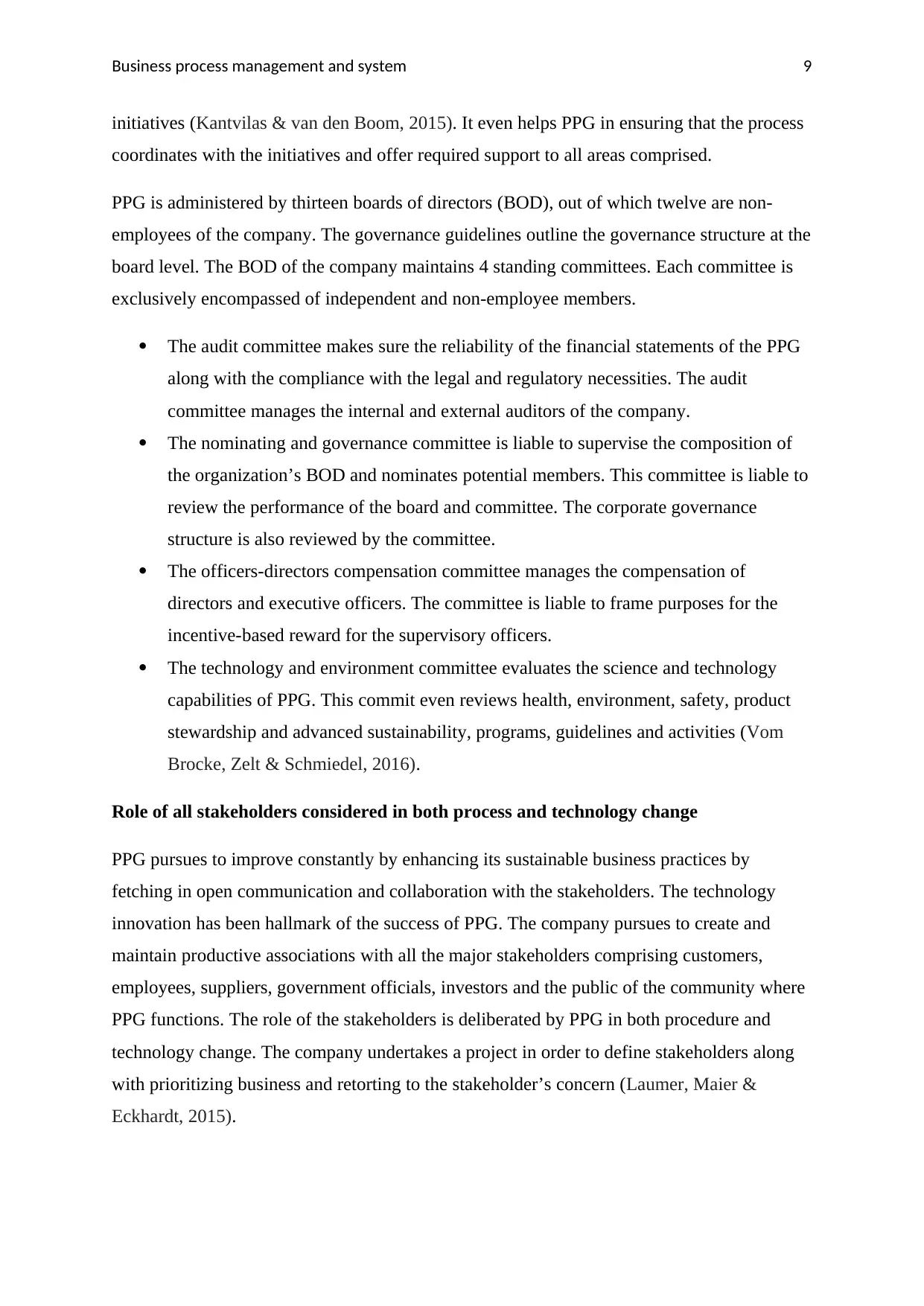
Business process management and system 9
initiatives (Kantvilas & van den Boom, 2015). It even helps PPG in ensuring that the process
coordinates with the initiatives and offer required support to all areas comprised.
PPG is administered by thirteen boards of directors (BOD), out of which twelve are non-
employees of the company. The governance guidelines outline the governance structure at the
board level. The BOD of the company maintains 4 standing committees. Each committee is
exclusively encompassed of independent and non-employee members.
The audit committee makes sure the reliability of the financial statements of the PPG
along with the compliance with the legal and regulatory necessities. The audit
committee manages the internal and external auditors of the company.
The nominating and governance committee is liable to supervise the composition of
the organization’s BOD and nominates potential members. This committee is liable to
review the performance of the board and committee. The corporate governance
structure is also reviewed by the committee.
The officers-directors compensation committee manages the compensation of
directors and executive officers. The committee is liable to frame purposes for the
incentive-based reward for the supervisory officers.
The technology and environment committee evaluates the science and technology
capabilities of PPG. This commit even reviews health, environment, safety, product
stewardship and advanced sustainability, programs, guidelines and activities (Vom
Brocke, Zelt & Schmiedel, 2016).
Role of all stakeholders considered in both process and technology change
PPG pursues to improve constantly by enhancing its sustainable business practices by
fetching in open communication and collaboration with the stakeholders. The technology
innovation has been hallmark of the success of PPG. The company pursues to create and
maintain productive associations with all the major stakeholders comprising customers,
employees, suppliers, government officials, investors and the public of the community where
PPG functions. The role of the stakeholders is deliberated by PPG in both procedure and
technology change. The company undertakes a project in order to define stakeholders along
with prioritizing business and retorting to the stakeholder’s concern (Laumer, Maier &
Eckhardt, 2015).
initiatives (Kantvilas & van den Boom, 2015). It even helps PPG in ensuring that the process
coordinates with the initiatives and offer required support to all areas comprised.
PPG is administered by thirteen boards of directors (BOD), out of which twelve are non-
employees of the company. The governance guidelines outline the governance structure at the
board level. The BOD of the company maintains 4 standing committees. Each committee is
exclusively encompassed of independent and non-employee members.
The audit committee makes sure the reliability of the financial statements of the PPG
along with the compliance with the legal and regulatory necessities. The audit
committee manages the internal and external auditors of the company.
The nominating and governance committee is liable to supervise the composition of
the organization’s BOD and nominates potential members. This committee is liable to
review the performance of the board and committee. The corporate governance
structure is also reviewed by the committee.
The officers-directors compensation committee manages the compensation of
directors and executive officers. The committee is liable to frame purposes for the
incentive-based reward for the supervisory officers.
The technology and environment committee evaluates the science and technology
capabilities of PPG. This commit even reviews health, environment, safety, product
stewardship and advanced sustainability, programs, guidelines and activities (Vom
Brocke, Zelt & Schmiedel, 2016).
Role of all stakeholders considered in both process and technology change
PPG pursues to improve constantly by enhancing its sustainable business practices by
fetching in open communication and collaboration with the stakeholders. The technology
innovation has been hallmark of the success of PPG. The company pursues to create and
maintain productive associations with all the major stakeholders comprising customers,
employees, suppliers, government officials, investors and the public of the community where
PPG functions. The role of the stakeholders is deliberated by PPG in both procedure and
technology change. The company undertakes a project in order to define stakeholders along
with prioritizing business and retorting to the stakeholder’s concern (Laumer, Maier &
Eckhardt, 2015).
Paraphrase This Document
Need a fresh take? Get an instant paraphrase of this document with our AI Paraphraser
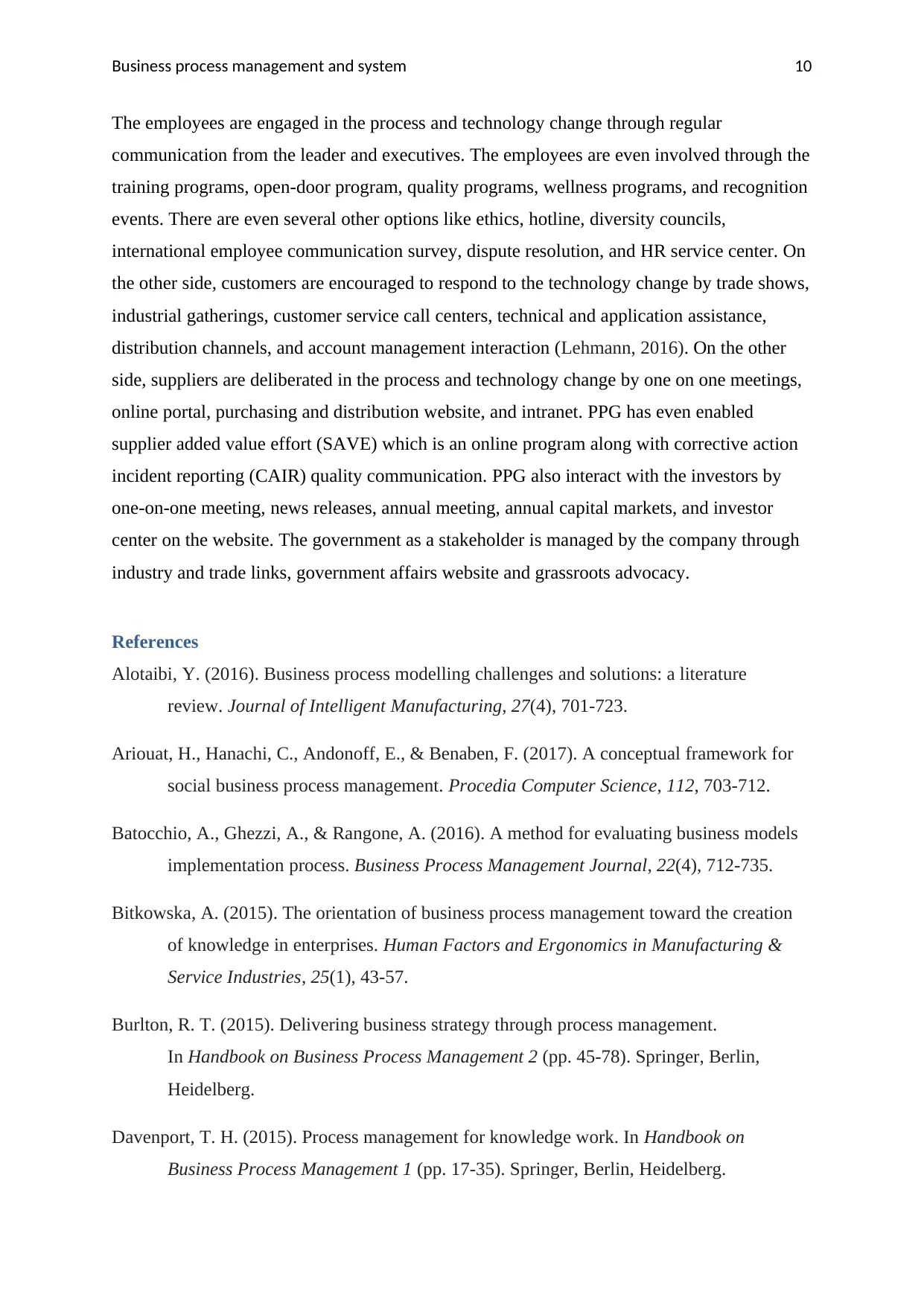
Business process management and system 10
The employees are engaged in the process and technology change through regular
communication from the leader and executives. The employees are even involved through the
training programs, open-door program, quality programs, wellness programs, and recognition
events. There are even several other options like ethics, hotline, diversity councils,
international employee communication survey, dispute resolution, and HR service center. On
the other side, customers are encouraged to respond to the technology change by trade shows,
industrial gatherings, customer service call centers, technical and application assistance,
distribution channels, and account management interaction (Lehmann, 2016). On the other
side, suppliers are deliberated in the process and technology change by one on one meetings,
online portal, purchasing and distribution website, and intranet. PPG has even enabled
supplier added value effort (SAVE) which is an online program along with corrective action
incident reporting (CAIR) quality communication. PPG also interact with the investors by
one-on-one meeting, news releases, annual meeting, annual capital markets, and investor
center on the website. The government as a stakeholder is managed by the company through
industry and trade links, government affairs website and grassroots advocacy.
References
Alotaibi, Y. (2016). Business process modelling challenges and solutions: a literature
review. Journal of Intelligent Manufacturing, 27(4), 701-723.
Ariouat, H., Hanachi, C., Andonoff, E., & Benaben, F. (2017). A conceptual framework for
social business process management. Procedia Computer Science, 112, 703-712.
Batocchio, A., Ghezzi, A., & Rangone, A. (2016). A method for evaluating business models
implementation process. Business Process Management Journal, 22(4), 712-735.
Bitkowska, A. (2015). The orientation of business process management toward the creation
of knowledge in enterprises. Human Factors and Ergonomics in Manufacturing &
Service Industries, 25(1), 43-57.
Burlton, R. T. (2015). Delivering business strategy through process management.
In Handbook on Business Process Management 2 (pp. 45-78). Springer, Berlin,
Heidelberg.
Davenport, T. H. (2015). Process management for knowledge work. In Handbook on
Business Process Management 1 (pp. 17-35). Springer, Berlin, Heidelberg.
The employees are engaged in the process and technology change through regular
communication from the leader and executives. The employees are even involved through the
training programs, open-door program, quality programs, wellness programs, and recognition
events. There are even several other options like ethics, hotline, diversity councils,
international employee communication survey, dispute resolution, and HR service center. On
the other side, customers are encouraged to respond to the technology change by trade shows,
industrial gatherings, customer service call centers, technical and application assistance,
distribution channels, and account management interaction (Lehmann, 2016). On the other
side, suppliers are deliberated in the process and technology change by one on one meetings,
online portal, purchasing and distribution website, and intranet. PPG has even enabled
supplier added value effort (SAVE) which is an online program along with corrective action
incident reporting (CAIR) quality communication. PPG also interact with the investors by
one-on-one meeting, news releases, annual meeting, annual capital markets, and investor
center on the website. The government as a stakeholder is managed by the company through
industry and trade links, government affairs website and grassroots advocacy.
References
Alotaibi, Y. (2016). Business process modelling challenges and solutions: a literature
review. Journal of Intelligent Manufacturing, 27(4), 701-723.
Ariouat, H., Hanachi, C., Andonoff, E., & Benaben, F. (2017). A conceptual framework for
social business process management. Procedia Computer Science, 112, 703-712.
Batocchio, A., Ghezzi, A., & Rangone, A. (2016). A method for evaluating business models
implementation process. Business Process Management Journal, 22(4), 712-735.
Bitkowska, A. (2015). The orientation of business process management toward the creation
of knowledge in enterprises. Human Factors and Ergonomics in Manufacturing &
Service Industries, 25(1), 43-57.
Burlton, R. T. (2015). Delivering business strategy through process management.
In Handbook on Business Process Management 2 (pp. 45-78). Springer, Berlin,
Heidelberg.
Davenport, T. H. (2015). Process management for knowledge work. In Handbook on
Business Process Management 1 (pp. 17-35). Springer, Berlin, Heidelberg.
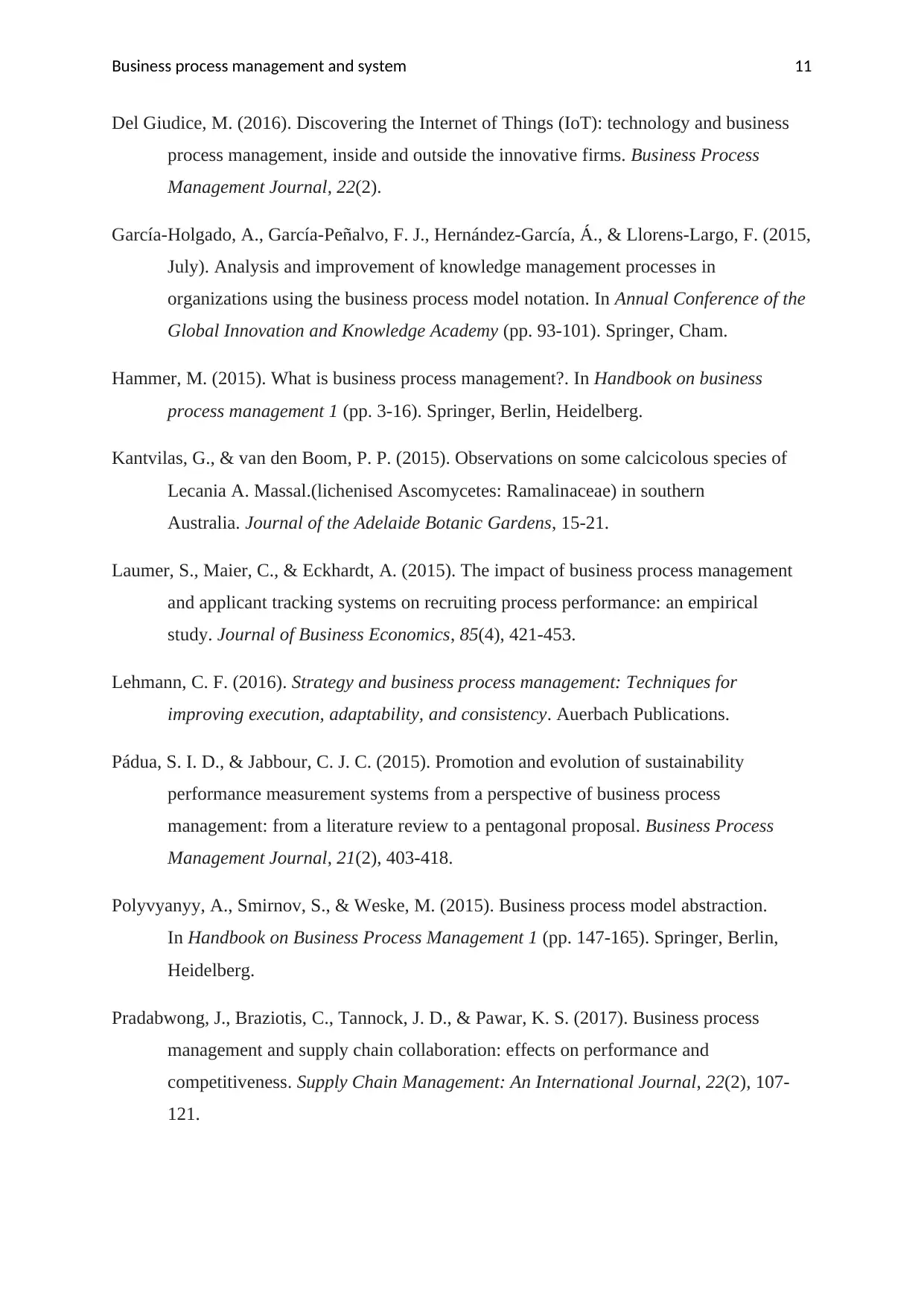
Business process management and system 11
Del Giudice, M. (2016). Discovering the Internet of Things (IoT): technology and business
process management, inside and outside the innovative firms. Business Process
Management Journal, 22(2).
García-Holgado, A., García-Peñalvo, F. J., Hernández-García, Á., & Llorens-Largo, F. (2015,
July). Analysis and improvement of knowledge management processes in
organizations using the business process model notation. In Annual Conference of the
Global Innovation and Knowledge Academy (pp. 93-101). Springer, Cham.
Hammer, M. (2015). What is business process management?. In Handbook on business
process management 1 (pp. 3-16). Springer, Berlin, Heidelberg.
Kantvilas, G., & van den Boom, P. P. (2015). Observations on some calcicolous species of
Lecania A. Massal.(lichenised Ascomycetes: Ramalinaceae) in southern
Australia. Journal of the Adelaide Botanic Gardens, 15-21.
Laumer, S., Maier, C., & Eckhardt, A. (2015). The impact of business process management
and applicant tracking systems on recruiting process performance: an empirical
study. Journal of Business Economics, 85(4), 421-453.
Lehmann, C. F. (2016). Strategy and business process management: Techniques for
improving execution, adaptability, and consistency. Auerbach Publications.
Pádua, S. I. D., & Jabbour, C. J. C. (2015). Promotion and evolution of sustainability
performance measurement systems from a perspective of business process
management: from a literature review to a pentagonal proposal. Business Process
Management Journal, 21(2), 403-418.
Polyvyanyy, A., Smirnov, S., & Weske, M. (2015). Business process model abstraction.
In Handbook on Business Process Management 1 (pp. 147-165). Springer, Berlin,
Heidelberg.
Pradabwong, J., Braziotis, C., Tannock, J. D., & Pawar, K. S. (2017). Business process
management and supply chain collaboration: effects on performance and
competitiveness. Supply Chain Management: An International Journal, 22(2), 107-
121.
Del Giudice, M. (2016). Discovering the Internet of Things (IoT): technology and business
process management, inside and outside the innovative firms. Business Process
Management Journal, 22(2).
García-Holgado, A., García-Peñalvo, F. J., Hernández-García, Á., & Llorens-Largo, F. (2015,
July). Analysis and improvement of knowledge management processes in
organizations using the business process model notation. In Annual Conference of the
Global Innovation and Knowledge Academy (pp. 93-101). Springer, Cham.
Hammer, M. (2015). What is business process management?. In Handbook on business
process management 1 (pp. 3-16). Springer, Berlin, Heidelberg.
Kantvilas, G., & van den Boom, P. P. (2015). Observations on some calcicolous species of
Lecania A. Massal.(lichenised Ascomycetes: Ramalinaceae) in southern
Australia. Journal of the Adelaide Botanic Gardens, 15-21.
Laumer, S., Maier, C., & Eckhardt, A. (2015). The impact of business process management
and applicant tracking systems on recruiting process performance: an empirical
study. Journal of Business Economics, 85(4), 421-453.
Lehmann, C. F. (2016). Strategy and business process management: Techniques for
improving execution, adaptability, and consistency. Auerbach Publications.
Pádua, S. I. D., & Jabbour, C. J. C. (2015). Promotion and evolution of sustainability
performance measurement systems from a perspective of business process
management: from a literature review to a pentagonal proposal. Business Process
Management Journal, 21(2), 403-418.
Polyvyanyy, A., Smirnov, S., & Weske, M. (2015). Business process model abstraction.
In Handbook on Business Process Management 1 (pp. 147-165). Springer, Berlin,
Heidelberg.
Pradabwong, J., Braziotis, C., Tannock, J. D., & Pawar, K. S. (2017). Business process
management and supply chain collaboration: effects on performance and
competitiveness. Supply Chain Management: An International Journal, 22(2), 107-
121.
⊘ This is a preview!⊘
Do you want full access?
Subscribe today to unlock all pages.

Trusted by 1+ million students worldwide
1 out of 13
Related Documents
Your All-in-One AI-Powered Toolkit for Academic Success.
+13062052269
info@desklib.com
Available 24*7 on WhatsApp / Email
![[object Object]](/_next/static/media/star-bottom.7253800d.svg)
Unlock your academic potential
Copyright © 2020–2025 A2Z Services. All Rights Reserved. Developed and managed by ZUCOL.




